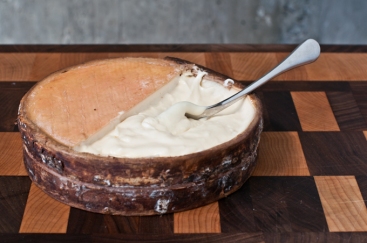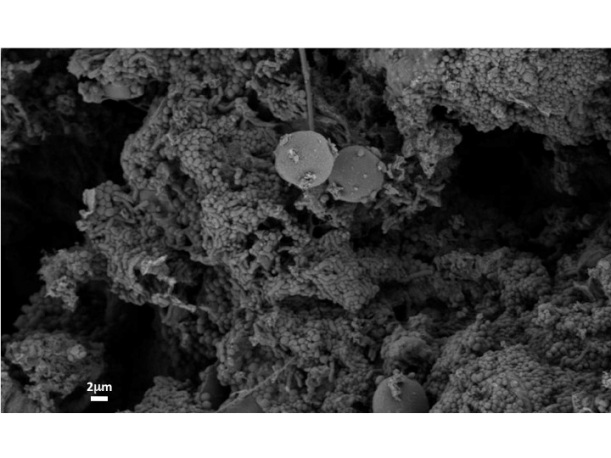This past Tuesday, I attended a talk by Rachel Dutton, doctor and Bauer Fellow, at Princeton University entitled “Food for Thought: Cheese as Model Microbial Ecosystem.” I was invited by my friend, Alan, whom I met in Florence this past summer and is attending Princeton for his master’s in synthetic organic chemistry (Hi, Alan!)
Unfortunately, I cannot give a summary of her talk because it was a presentation of data on a project that is not yet complete. However, she was able to send me some really amazing photos of microbes on cheese.
What I can share is the work that Rachel Dutton has done up to now.
THE DUTTON LAB
Rachel’s lab is located at Harvard University, in the FAS Center for Systems Biology. The goal of her research is to identify the mechanisms and principles through which microbial communities function. Coming to an understanding of the formation, function, and evolution of microbial ecosystems is seen as one of the most important challenges facing microbiology.
Rachel has observed that “microbes usually do not exist as individuals in nature, but as part of complex, multi-species communities, however, microbes have traditionally been studied as individuals in the laboratory.”
The Dutton lab “will apply a range of culture-dependent and independent methods to study the microbial diversity in the surface-associated communities that make up the rind, on identifying and characterizing inter-species interactions, and on developing an experimental model system to study microbial ecosystems.” (Bauer Fellows Profile)
In order to fully understand how microbes function within the context of the complex communities in which they exist outside of the laboratory, model systems are needed. The lab found cheese rinds to serve as that model system. The lab studies patterns in natural microbial cheese communities and then tests hypotheses in the lab with in vitro models of community formation with a mixture of dried cheese curd powder and agar. (The Dutton Lab Website)
CHEESE AS A MODEL SYSTEM
Microbes…
Determine the Flavors, Smells, and Textures
Rachel Dutton is attracted to cheese because of the simplified, experimentally tractable microbial ecosystems found growing on the surface and cheeses are ideal models to study the behavior of microbes in complex communities. These communities, and their rich assembly of metabolic capacities, contribute much of the diversity in flavors, smells, and textures of the hundreds of different varieties of cheeses. Camembert is covered entirely of microscopic organisms that contribute to the creation and consistancy of the paste, the unique flavors, and the familiar bloomy white rind.
Are Able to Communicate
The technical term for this community of organisms is ‘biofilm’ – a web of interconnected microbes that rely on each other to create their own environment. Interestingly, biofilms are not just a large swath of microbes, but organized masses of organisms that have been proven to have communication capabilities. In a process called quorum sensing, individual cells constantly send out and measure chemical signals. Through these chemical signals, if a bacterium or fungus can recognize enough of its own kind (or enough other species) in the area, the cells switch from acting as individuals to acting as part of a community of connected organisms.
Protect the cheese
With the addition of strands of protein and sugars, the microbes weave themselves with these other molecules to become much tougher. This toughness proves beneficial for cheesemakers in that the biofilm resists the growth of undesirable bacteria and mold, while regulating the flow of gas and moisture into and out of the cheese.
Can Have an Extremely Diverse Community
Industrial cheesemaking techniques ensure that cheeses are inoculated with just one or two key species, so a commercial Brie might be dominated by only a single strain of Penicillium camemberti. While this method does keep cheese production consistent, it doesn’t provide complex, interesting flavors as found on many artisinal cheeses.
Cheesemakers carefully control each element in a cheese’s creation so that the right milk is colonized by the right bacteria and fungi at the right time. Cheese aging caves are kept at specific temperatures and humidities to cultivate desired species of fungi. Any slight adjustment in these numbers could cause an explosive bloom of an unwanted microbes.
The students in Rachel Dutton’s undergraduate lab class at Harvard analyzed the rind of Winnimere, a cheese produced at Jasper Hill Farm, VT, and

Winnimere Cheese from Jasper Hill Farm (http://www.cellarsatjasperhill.com/)
found an “exceptionally cosmopolitan” community of microorganisms living there. The rind of Jasper Hill’s Winnimere is washed in beer brewed from microbes living in the cheese’s aging cave. It was not unexpected that many salt-loving (halophilic) bacteria were discovered on the rind, but what did come as a surprise was the range of other unfamiliar bugs that are also found in places like Etruscan tombs, Tunisian oil wells, or Arctic sea ice.
Culture magazine commented that the discovery of these microbes on cheese is a far cry from the “big three” that dairy scientists generally focus on: the Lactococcus bacterial strains that produce the cheese paste, the Penicillium fungi that produce blue and bloomy rinds, and the Brevibacterium that supply the pungent pieds-de-Dieu aroma of washed rinds.
While the exact role of each of the oddball microbes found in Winnimere isn’t known, it is understood that without this specific mix living on the rind, Winnimere wouldn’t have its unique flavor. The Dutton lab is working hard to figure out the purpose of each microbe, and their interaction within the larger cheese rind community.
An article in The New York Times about Rachel Dutton’s lab states that “…as word about the lab’s work spread, first among microbiologists, then among cheesemakers, Ms. Dutton’s in-box filled with requests from nonscientists, including chefs, bakers and even a pickle maker in Berkeley, Calif. Packages started showing up at her office, containing food samples for her to analyze. …Chefs are looking for a signature taste, something that is completely unique to their location. “What makes terroir is the microbes. It’s literally what’s in the air.”
“There really is no one else doing what she is doing,” said Mr. McGee, a contributor to The New York Times Dining section. “Academic microbiologists have not taken an interest in small-scale fermentation, focusing on food safety rather than food quality. There is really only one person at the moment.” And Vince Razionale, the cheese buyer for Cambridge-based Formaggio Kitchen has said that “her work was described as “groundbreaking.”
In the bigger picture, beyond developing cheese textures and flavors, Dr. Dutton sees cheese as a model for how all kinds of microbial systems work. Helping researchers better understand microbial communities could mean that cheese could act as a proxy for the biofilm of an oil-slicked wetland or the distressed lung of a cystic fibrosis sufferer.
—–
REFERENCES
A majority of this post is a summarization of the article Microbe Managing – The Lifesaving Potential of Cheese Bacteria written by Will Fertman for Culture magazine.
Will Fertman. Microbe Managing – The Lifesaving Potential of Cheese Bacteria. Culture magazine, Fall 2012
http://www.culturecheesemag.com/autumn_talk_microbes
Peter Andrew Smith. For Gastronomists, a Go-To Microbiologist. New York Times, September 17, 2012
http://www.nytimes.com/2012/09/19/dining/for-gastronomists-a-go-to-microbiologist.html?_r=0
FAS Center for Systems Biology Bauer Fellows Program Profile page
http://sysbio.harvard.edu/csb/research/dutton.html
The Dutton Lab website
https://sites.google.com/site/theduttonlab/

